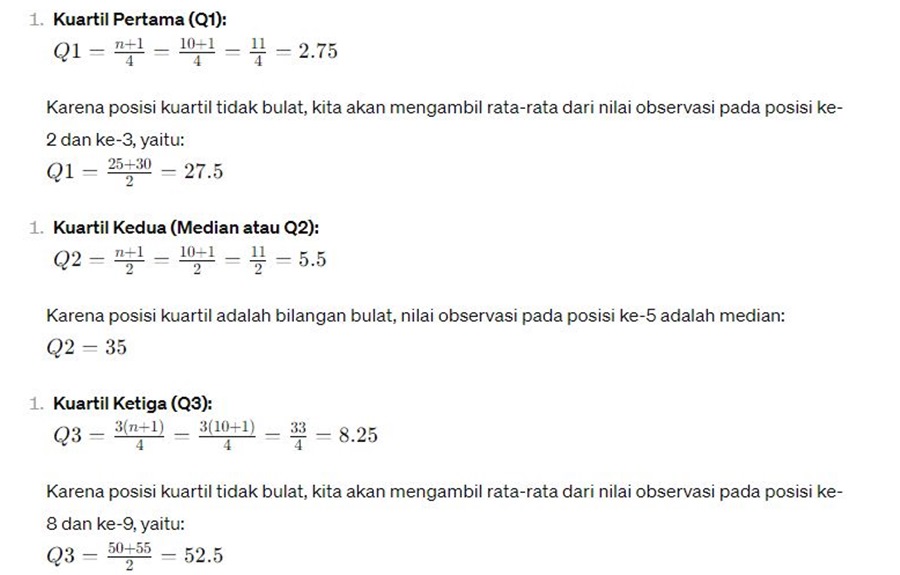foto: freepik.com
Brilio.net - In statistics, you will be introduced to data processing. One of them is dividing a group of data, sorting the data and finding the middle value. There are various terms that refer to data processing in statistics, including data median and data quartiles. Although both aim to find the middle value of data, they have various differences that must be understood.
The median is the middle value of a set of data that has been sorted sequentially. To find the median, the data is sorted from smallest to largest value or vice versa, and the median value is the middle value of the data sequence. If the number of data is odd, then the median is the value in the middle. However, if the amount of data is even, the median is the average of the two middle values.
Meanwhile, quartiles are values that divide data into four equal parts , each of which covers a quarter of the total data. In other words, quartiles are values that divide data into four equal parts. This means, when the data is sorted in ascending order (from smallest to largest value), there are three points that divide the data into four groups that have the same or almost the same number of observations.
There are three quartiles that are generally used:
1. First Quartile (Q1): This is the middle value of the first half of the data after sorting. In other terms, 25% of the data is below the Q1 value.
2. Second Quartile (Q2): The second quartile is the middle value of all the data after sorting. Q2 is the same as the median. As a result, 50% of the data is below Q2 and the other 50% is above it.
3. Third Quartile (Q3): The third quartile is the middle value of the second half of the data after sorting. In other words, 75% of the data is below the Q3 value.

photo: quipper.com
The main difference between single data quartiles and grouped data quartiles is in the way the data is processed. Single data quartiles are used when we have single data that has been sorted, while grouped data quartiles are used when we have data that has been grouped into intervals and frequencies.
The definition of quartiles in statistics can be divided into two concepts depending on how the data is processed:
Single data quartiles are values that divide a single data set into four equal parts. This means that when the data is sorted, there are three points that divide the data into four groups that have the same or almost the same number of observations. The first quartile (Q1), second quartile (Q2), and third quartile (Q3) represent values that divide the data into four equal parts. The definition of single data quartiles was explained previously in the previous question.
Quartiles of grouped data refer to the values that divide the frequency distribution of grouped data into four equal parts. When data is organized into groups of intervals, quartiles are calculated using a formula that takes into account the frequency of observations in each interval. Grouped quartiles are usually calculated using special formulas or methods, such as linear interpolation, to determine quartile values based on the frequency distribution of the given data.
The formula for calculating quartiles on single data depends on the position of the quartile you want to calculate:

photo: special
Here, n is the total number of observations in the data. If n is odd, the observation position will be an integer, and if n is even, the observation position may be the average of the two middle values.
(mg/Zidan Fajri)
Example of a single data quartile problem and its solution.
Determine the first quartile (Q1), second quartile (Q2), and third quartile (Q3) from the following data: 15,20,25,30,35,40,45,50,55,6015,20,25,30,35 ,40,45,50,55,60
Solution:
The first step is to sort the data from smallest to largest:
15,20,25,30,35,40,45,50,55,6015,20,25,30,35,40,45,50,55,60
We can use the previously mentioned formula to calculate the quartile position:

photo: special
So, the result is:
First Quartile (Q1) = 27.5
Second Quartile (Median or Q2) = 35
Third Quartile (Q3) = 52.5
Determine the first quartile (Q1), second quartile (Q2), and third quartile (Q3) from the following data: 12,15,18,20,22,25,28,30,32,3512,15,18,20,22 ,25,28,30,32,35
Solution:
The first step is to sort the data from smallest to largest:
12,15,18,20,22,25,28,30,32,3512,15,18,20,22,25,28,30,32,35

photo: special
So, the result is:
First Quartile (Q1) = 16.5
Second Quartile (Median or Q2) = 22
Third Quartile (Q3) = 29
Determine the first quartile (Q1), second quartile (Q2), and third quartile (Q3) from the following data: 10,15,20,25,30,35,40,45,50,5510,15,20,25,30 ,35,40,45,50,55
Solution:
The first step is to sort the data from smallest to largest:
10,15,20,25,30,35,40,45,50,5510,15,20,25,30,35,40,45,50,55
We have a total of 10 observations in the data.

photo: special
So, the result is:
First Quartile (Q1) = 17.5
Second Quartile (Median or Q2) = 30
Third Quartile (Q3) = 47.5
That's how to solve examples of quartile problems on single data. Hopefully this explanation is useful! If you have any further questions, don't hesitate to ask.
(brl/wen)